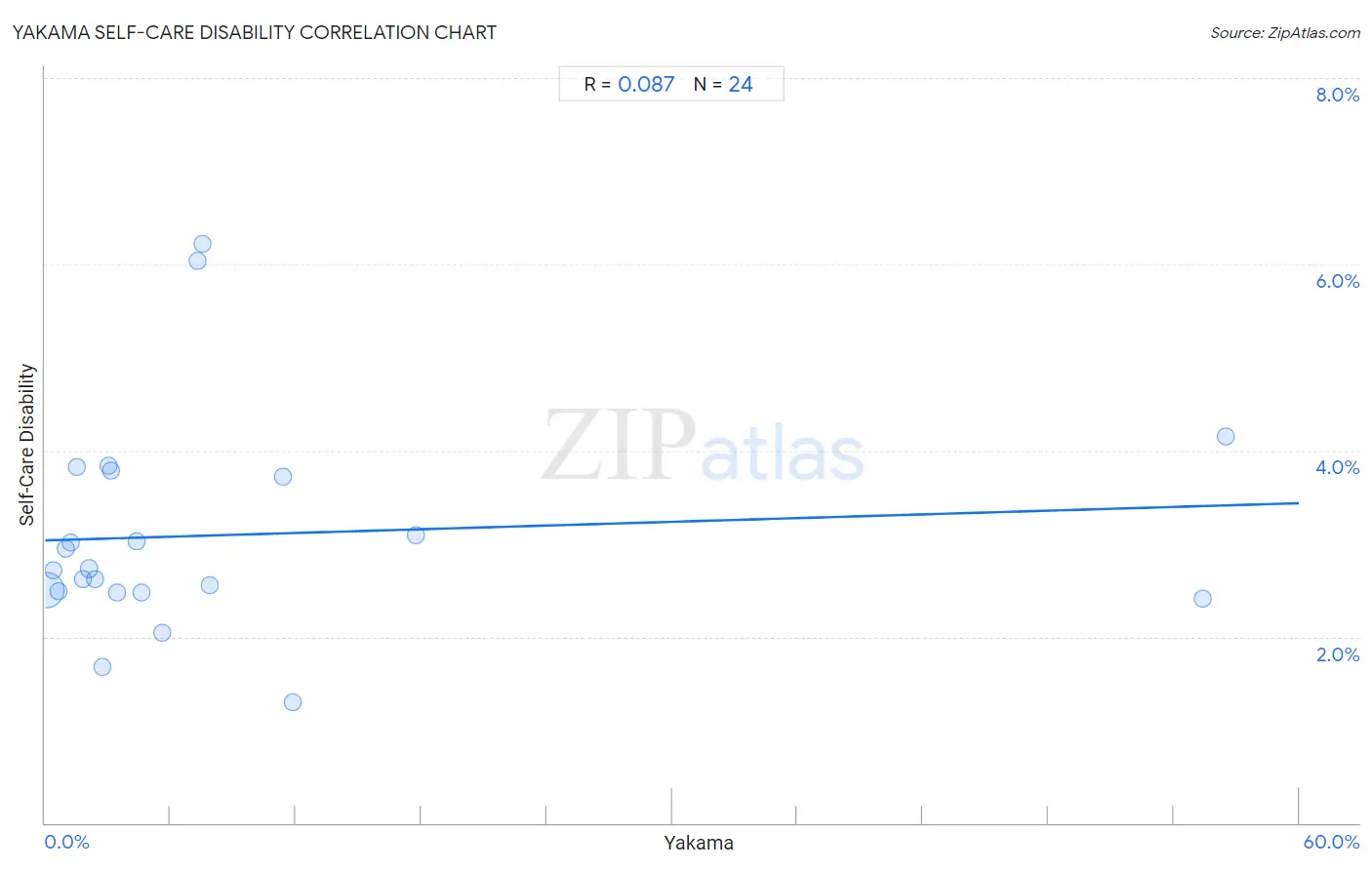Yakama Self-Care Disability
COMPARE
Yakama
Select to Compare
Self-Care Disability
Yakama Self-Care Disability
2.7%
SELF-CARE DISABILITY
0.1/ 100
METRIC RATING
274th/ 347
METRIC RANK
Yakama Self-Care Disability Correlation Chart
The statistical analysis conducted on geographies consisting of 19,914,398 people shows a slight positive correlation between the proportion of Yakama and percentage of population with self-care disability in the United States with a correlation coefficient (R) of 0.087 and weighted average of 2.7%. On average, for every 1% (one percent) increase in Yakama within a typical geography, there is an increase of 0.0067% in percentage of population with self-care disability.

It is essential to understand that the correlation between the percentage of Yakama and percentage of population with self-care disability does not imply a direct cause-and-effect relationship. It remains uncertain whether the presence of Yakama influences an upward or downward trend in the level of percentage of population with self-care disability within an area, or if Yakama simply ended up residing in those areas with higher or lower levels of percentage of population with self-care disability due to other factors.
Demographics Similar to Yakama by Self-Care Disability
In terms of self-care disability, the demographic groups most similar to Yakama are Immigrants from Trinidad and Tobago (2.7%, a difference of 0.0%), Mexican (2.7%, a difference of 0.060%), Japanese (2.7%, a difference of 0.13%), Immigrants from Ukraine (2.7%, a difference of 0.19%), and Immigrants from Laos (2.7%, a difference of 0.20%).
| Demographics | Rating | Rank | Self-Care Disability |
| Yaqui | 0.1 /100 | #267 | Tragic 2.7% |
| Immigrants from Mexico | 0.1 /100 | #268 | Tragic 2.7% |
| U.S. Virgin Islanders | 0.1 /100 | #269 | Tragic 2.7% |
| Immigrants from Micronesia | 0.1 /100 | #270 | Tragic 2.7% |
| Trinidadians and Tobagonians | 0.1 /100 | #271 | Tragic 2.7% |
| Immigrants from Laos | 0.1 /100 | #272 | Tragic 2.7% |
| Mexicans | 0.1 /100 | #273 | Tragic 2.7% |
| Yakama | 0.1 /100 | #274 | Tragic 2.7% |
| Immigrants from Trinidad and Tobago | 0.1 /100 | #275 | Tragic 2.7% |
| Japanese | 0.1 /100 | #276 | Tragic 2.7% |
| Immigrants from Ukraine | 0.1 /100 | #277 | Tragic 2.7% |
| Ottawa | 0.1 /100 | #278 | Tragic 2.7% |
| Iroquois | 0.1 /100 | #279 | Tragic 2.7% |
| Hispanics or Latinos | 0.1 /100 | #280 | Tragic 2.7% |
| Immigrants from Iraq | 0.0 /100 | #281 | Tragic 2.7% |
Yakama Self-Care Disability Correlation Summary
| Measurement | Yakama Data | Self-Care Disability Data |
| Minimum | 0.033% | 1.3% |
| Maximum | 56.5% | 6.2% |
| Range | 56.5% | 4.9% |
| Mean | 8.9% | 3.1% |
| Median | 3.3% | 2.7% |
| Interquartile 25% (IQ1) | 1.6% | 2.5% |
| Interquartile 75% (IQ3) | 7.7% | 3.8% |
| Interquartile Range (IQR) | 6.1% | 1.3% |
| Standard Deviation (Sample) | 15.1% | 1.2% |
| Standard Deviation (Population) | 14.8% | 1.1% |
Correlation Details
| Yakama Percentile | Sample Size | Self-Care Disability |
[ 0.0% - 0.5% ] 0.033% | 19,058,180 | 2.5% |
[ 0.0% - 0.5% ] 0.38% | 567,932 | 2.7% |
[ 0.5% - 1.0% ] 0.66% | 83,410 | 2.5% |
[ 0.5% - 1.0% ] 1.00% | 71,755 | 2.9% |
[ 1.0% - 1.5% ] 1.22% | 12,367 | 3.0% |
[ 1.0% - 1.5% ] 1.49% | 5,975 | 3.8% |
[ 1.5% - 2.0% ] 1.79% | 14,006 | 2.6% |
[ 2.0% - 2.5% ] 2.12% | 44,079 | 2.7% |
[ 2.0% - 2.5% ] 2.42% | 6,405 | 2.6% |
[ 2.5% - 3.0% ] 2.71% | 1,768 | 1.7% |
[ 3.0% - 3.5% ] 3.03% | 659 | 3.8% |
[ 3.0% - 3.5% ] 3.16% | 1,266 | 3.8% |
[ 3.0% - 3.5% ] 3.43% | 1,078 | 2.5% |
[ 4.0% - 4.5% ] 4.39% | 569 | 3.0% |
[ 4.5% - 5.0% ] 4.60% | 3,153 | 2.5% |
[ 5.5% - 6.0% ] 5.58% | 11,112 | 2.0% |
[ 7.0% - 7.5% ] 7.32% | 205 | 6.0% |
[ 7.5% - 8.0% ] 7.54% | 199 | 6.2% |
[ 7.5% - 8.0% ] 7.88% | 13,015 | 2.6% |
[ 11.0% - 11.5% ] 11.38% | 1,195 | 3.7% |
[ 11.5% - 12.0% ] 11.87% | 640 | 1.3% |
[ 17.5% - 18.0% ] 17.73% | 13,145 | 3.1% |
[ 55.0% - 55.5% ] 55.39% | 1,724 | 2.4% |
[ 56.5% - 57.0% ] 56.51% | 561 | 4.2% |